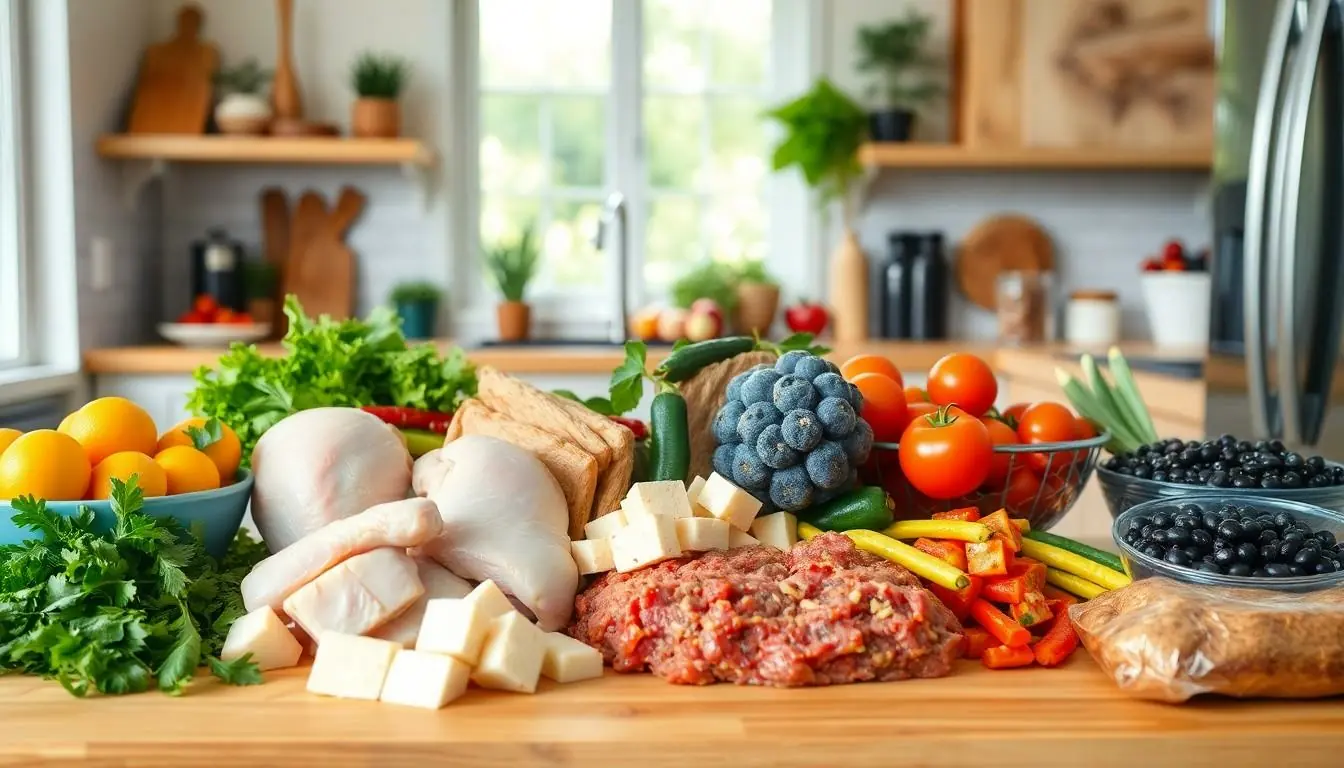Eating low-carb doesn’t have to break the bank or leave the family feeling deprived. Many budget-conscious families are discovering creative ways to prepare delicious keto-friendly meals without sacrificing taste or their financial goals. From savory casseroles to one-pan wonders these meals can satisfy even the pickiest eaters.
While most people think low-carb eating means expensive specialty ingredients and fancy cuts of meat smart shoppers know better. By focusing on seasonal vegetables affordable proteins and simple cooking techniques it’s possible to create nutritious family-friendly meals that won’t spike blood sugar or empty wallets. The key lies in strategic meal planning bulk buying and knowing which ingredients deliver the most bang for your buck while keeping those pesky carbs in check.
Table of Contents
ToggleUnderstanding Low Carb Meal Planning
Successful low carb meal planning combines strategic shopping with proper ingredient selection. A well-stocked kitchen reduces unnecessary purchases while maintaining nutritional balance.
Key Low Carb Ingredients to Keep Stocked
Essential pantry items for low carb cooking include olive oil, coconut oil, almond flour, coconut flour, and sugar substitutes like stevia or monk fruit. Fresh ingredients encompass eggs, heavy cream, cheese varieties (cheddar, mozzarella, cream cheese) and butter. Proteins focus on chicken thighs, ground beef, pork cuts, canned tuna and frozen fish fillets. Stock vegetables include cauliflower, broccoli, zucchini, spinach, cabbage and bell peppers. Shelf-stable items feature canned tomatoes, chicken broth, nuts (almonds, walnuts), seeds (chia, flax) and herbs (basil, oregano, thyme).
Money-Saving Shopping Strategies
Shopping sales cycles creates opportunities to stock up on meat at 30-50% discounts. Buying whole chickens at $2-3 per pound versus pre-cut pieces saves $2-4 per pound. Frozen vegetables cost 40% less than fresh alternatives while maintaining nutritional value. Bulk purchasing nuts, seeds and low carb flours from warehouse stores reduces per-unit costs by 25%. Price comparison apps identify the lowest local prices for specific items. Store brands offer comparable quality to name brands at 15-30% savings. Shopping seasonal produce ensures better prices with items often 50% cheaper during peak growing periods.
Budget-Friendly Low Carb Protein Options
Maintaining a low-carb diet with adequate protein intake remains achievable on a tight budget. Smart protein selection combines nutritional value with cost-effectiveness to create satisfying family meals.
Affordable Meat Choices
Chicken thighs cost 60% less than chicken breasts while offering more flavor and healthy fats. Ground beef at 80/20 lean-to-fat ratio provides excellent nutrition at $4-5 per pound. Pork shoulder drops to $2-3 per pound when bought in bulk quantities of 8-10 pounds. Here’s a cost comparison of budget-friendly meat options:
| Protein Source | Average Cost/lb | Protein/4oz |
|---|---|---|
| Chicken thighs | $1.99 | 22g |
| Ground beef | $4.50 | 21g |
| Pork shoulder | $2.50 | 23g |
| Canned tuna | $2.75 | 20g |
Plant-Based Protein Alternatives
| Plant Protein | Net Carbs/Serving | Protein/Serving | Cost/Package |
|---|---|---|---|
| Tofu | 1g | 10g | $2.00 |
| Black soybeans | 2g | 11g | $1.50 |
| Tempeh | 3g | 15g | $3.99 |
| Lupini beans | 0g | 12g | $2.50 |
Easy Low Carb Family Dinner Recipes
These budget-friendly low carb recipes feature simple ingredients with minimal preparation time. Each dish combines protein-rich components with nutritious vegetables to create satisfying family meals.
One-Pan Chicken and Vegetables
Sheet pan meals maximize flavor while minimizing cleanup time. Place chicken thighs with seasoned vegetables like broccoli, cauliflower, zucchini on a large baking sheet. Toss ingredients with olive oil, garlic powder, salt, pepper before roasting at 400°F for 25 minutes. Add different vegetable combinations such as Brussels sprouts, bell peppers or asparagus based on seasonal availability. Cooking proteins with vegetables allows their natural juices to create rich flavors throughout the dish.
Ground Beef Casseroles
Ground beef casseroles offer versatile options for feeding families on a budget. Mix browned ground beef with riced cauliflower, cream cheese, eggs, shredded cheese to create a hearty base. Layer ingredients in a baking dish with low carb vegetables like spinach, mushrooms or zucchini. Top with additional cheese before baking at 350°F for 30 minutes until golden brown. Create variations using different seasonings such as Italian herbs, Mexican spices or ranch flavoring to prevent meal fatigue. These casseroles provide leftovers for quick lunches or dinners throughout the week.
Meal Prep Tips to Save Time and Money
Effective meal preparation reduces cooking time throughout the week while maximizing grocery savings. Strategic meal prep creates a foundation for consistent low-carb family dining within budget constraints.
Batch Cooking Basics
Batch cooking multiplies recipe portions to create ready-to-eat meals for 4-5 days. Double recipes during weekend prep sessions to stock the freezer with family portions of low-carb favorites like meatballs, taco meat or chicken thighs. Cook multiple proteins at once – roast a whole chicken while baking egg cups provides protein variety for the week. Prepare versatile bases such as cauliflower rice, zucchini noodles or seasoned ground beef to mix with different sauces or toppings. Steam large batches of vegetables then portion into containers for quick side dishes. Label each container with contents and date to track freshness.
Smart Storage Solutions
Air-tight glass containers preserve batch-cooked meals in the refrigerator for 3-4 days. Divide portions into meal-sized containers to grab quickly during busy weekdays. Store cut vegetables in containers lined with paper towels to absorb excess moisture. Freeze prepared meals flat in freezer bags to maximize space – lay bags horizontally until frozen then store vertically. Use clear containers labeled with contents dates to track inventory. Pack individual portions in reusable silicone bags for easy lunch assembly. Store prepared proteins separately from vegetables to maintain optimal texture. Keep chopped herbs fresh by wrapping in damp paper towels inside storage bags.
Making Low Carb Meals Kid-Friendly
Low carb meals become more appealing to children through creative presentation techniques. Simple ingredient substitutions maintain familiar flavors while reducing carbohydrate content in family favorites.
Simple Vegetable Swaps
Cauliflower transforms into rice alternatives for stir-fries bases through quick food processor pulses. Zucchini noodles replace pasta in classic dishes using a spiralizer or vegetable peeler. Mashed cauliflower offers a creamy texture similar to potatoes when blended with butter garlic. Bell peppers create colorful taco shells or sandwich wraps without bread. Portobello mushrooms serve as pizza crusts topped with cheese sauce tomatoes. Spaghetti squash strands mimic traditional pasta when roasted then forked into strings. Lettuce leaves wrap sandwich fillings creating fresh crunchy alternatives to bread. Cabbage leaves roll around meat fillings replacing pasta in lasagna dishes.
Creative Presentation Ideas
Cookie cutters shape vegetables into fun stars hearts circles attracting kids’ attention. Colorful arrangements on plates create faces animals patterns using different vegetables. Kebab skewers thread meat cheese vegetables making handheld combinations kids enjoy. Bento-style lunch boxes separate foods into appealing compartments. Mini muffin tins create perfect portions of egg bites frittatas meatballs. Food picks decorated with characters secure roll-ups wraps sandwiches. Dipping bowls offer ranch avocado cream cheese sauces encouraging vegetable consumption. Naming dishes creatively like “dragon trees” for broccoli “monster mash” for cauliflower generates excitement. Rainbow plates incorporate vegetables of different colors making meals visually appealing.
Conclusion
Living a low-carb lifestyle doesn’t have to strain the family budget. With smart shopping strategies creative meal planning and budget-friendly protein choices families can maintain a healthy low-carb diet without sacrificing flavor or variety.
The key lies in strategic preparation thoughtful ingredient selection and making the most of available resources. By implementing these practical tips and techniques families can enjoy nutritious low-carb meals that keep everyone satisfied and excited about mealtime while staying within their financial means.
Remember that successful low-carb family dining is a journey that becomes easier and more cost-effective with practice. When armed with the right knowledge and tools any family can make low-carb eating both sustainable and affordable.




